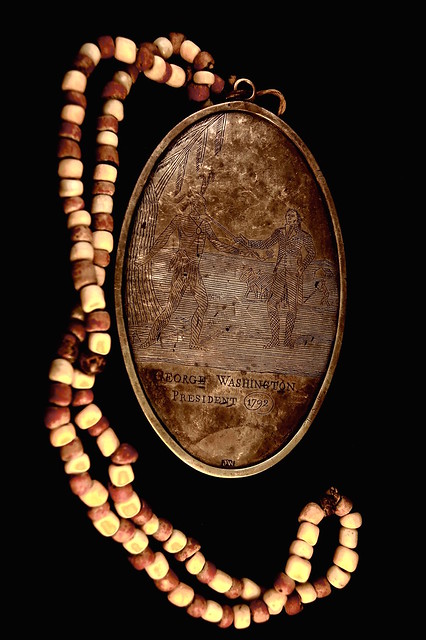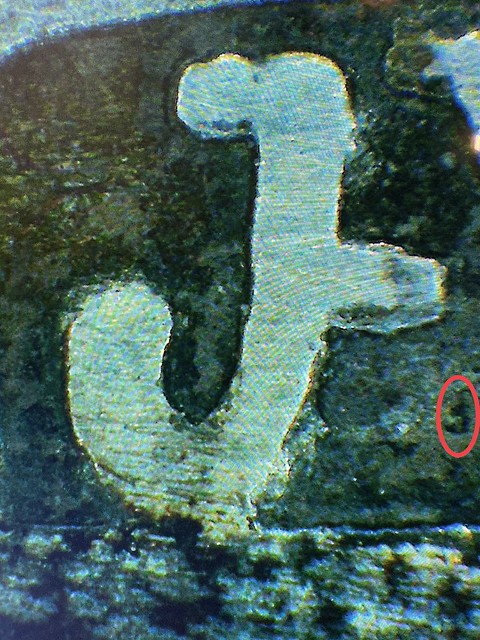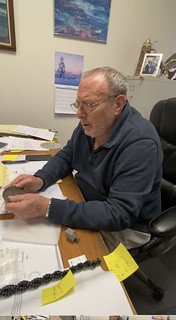
PREV ARTICLE
NEXT ARTICLE
FULL ISSUE
PREV FULL ISSUE
JOSEPH LOVELL WRIGHT JR: PEACE MEDAL DESIGNER?Reader Gary C. Gianotti submitted this summary of his research into the maker of a recently discovered silver oval George Washington Indian Peace Medal discussed in The Colonial Newsletter #159 (December 2015). See the link below to read the full article by Gary and Ron Miller and subsequent reactions by Bill Nyberg and others. -Editor Identification of the only two known 1792 hallmarked medals the “Wright” way Gary C. Gianotti FSA Scot Back in 2011, numismatic, exonumia pioneer and authority of hand engraved George Washington silver oval Indian peace medals George Fuld had made one of his last great discoveries before passing in 2013. While he was coauthoring the Gilcrease Musuem’s peace medals exhibit book “Peace Medals, Negotiating Power in Early America”, George with the coauthors presented his discovery of the Woolaroc Museum, GW Indian Peace medal on the front cover of the book. Adding a write up on the medal's discovery in the book, George describes the medal as a very important discovery of an unknown silversmith, who hallmarked the medal “JW” - he medal being the only hallmarked 1792 specimen medal known to exist, of all 1792 GW silver oval IPM’s that are known to be authentic, with it possibly being made by a silversmith named Joseph Wyatt! Coin World published the story Nov, 30th 2011 on the book, regarding the Gilcrease Museums Peace medal exhibit. Coin World wrote a paragraph in the article about George's discovery of the Woolaroc medal being featured on the book cover and George’s discovery of this unknown hallmarked medal.
George was mistaken on the possibility of the silversmith being Joseph Wyatt of London. Wyatt never stepped foot in America until after 1793 as original assayer records state, as well as documented 1793 Wyatt pieces specify. Researcher David Fegley of Pennsylvania had examined the N.Y. specimen under a digital microscope and discovered that the hallmark “JW” is “JLW” with a clearly cut letter “J” between the “JL” & “W” that represents Joseph Lovell Wright Junior. The dash on the “J” is an “L” because dashes were not used in that time period. Dots were being used and Wyatt used dots on his hallmarks that are documented. Even the renowned silversmith Joseph Richardson who made the most exquisite engraved peace medals, commonly added an additional smaller “J” on some of his hallmarks to distinguish him as Joseph Richardson Junior from his fathers work. Most all of Josephs Wright’s works from paintings to his medals have additional letter initials manipulated to specifically distinguish him from the renowned painter in England with his exact same name, Joseph Wright of Derby.
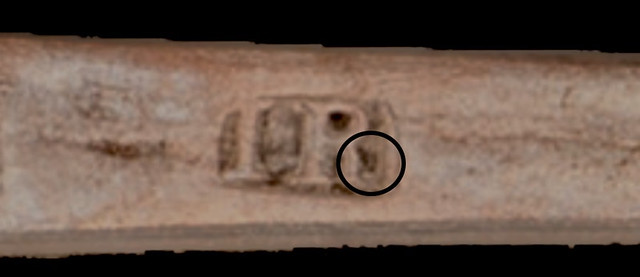 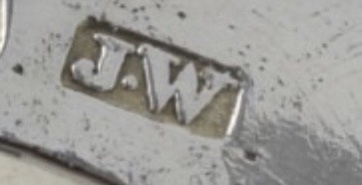 If readers are skeptical of this evidence, I can prove here that both the Woolaroc and NY medal were made by Wright. Wright was factually a Master Mason, his documented 1787 hand signed watercolor of a lady, visibly shows the numbers “47” that represents the numeric symbolism of a Master Mason. Called the 47th Problem of Euclid, simply being described in most Masonic books as a general love for Arts & Sciences that associates mathematic ratios with geometry. Wright cunningly transformed the nose of GW’s face on both the Woolaroc and NY medal as the number 47 that’s inverted. The NY medal with HDR camera imaging shows two more additional 47’s on opposite sides of the ground or field of the medal. The nose showing the 4 on the NY medal is slightly worn, but Wright adds an additional number 47 on GW’s cheek. Regardless, after an exhausting research with trying to find Joseph's Masonic records, the signed, dated and documented work of Wright's water color of a lady in 1786, proves he was a Master Mason using the 47 symbolism in his art designs in an esoteric manner that the average eye does not see in plain view. 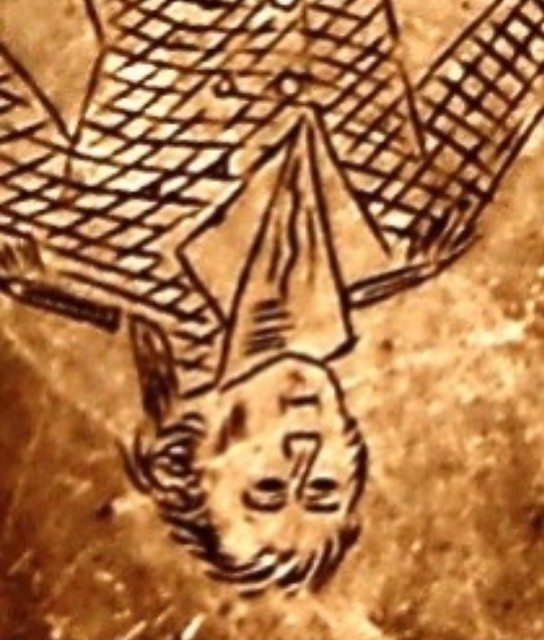 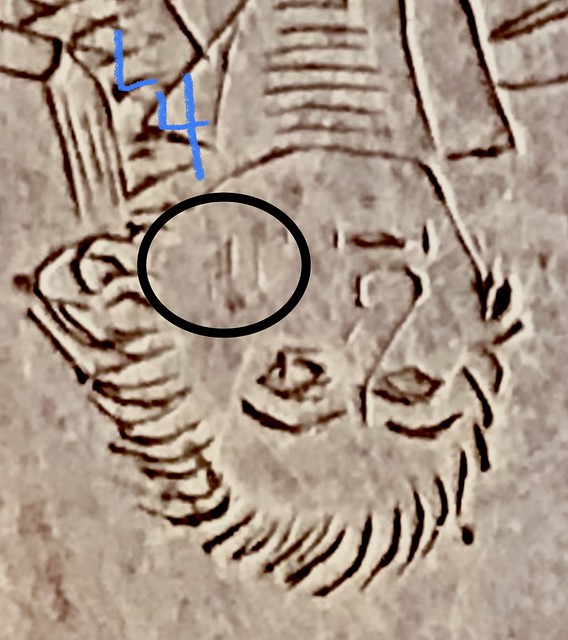
Images 1 and 2 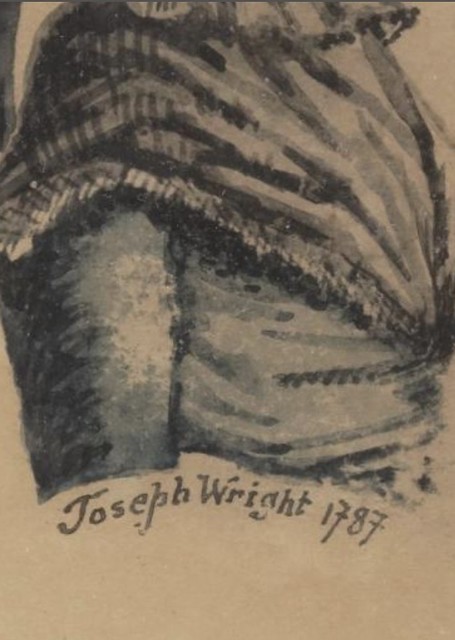 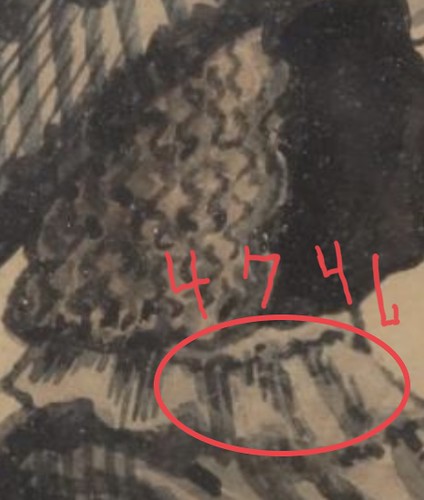
Images 3 and 4 The first image above is the Woolaroc medal, the nose shows the 4 as part of the 7. The second image is the NY medal with a faded 4 on the 7 (nose) with an additional 47 on the cheek circled. The next to images are Joseph's watercolor of the lady, showing exceptional numbers 4 & 7 in great detail. The NY specimens 4 on the cheek, to the right and inverted shows the number 7 in the identical manor as the second 47 on the water color of the lady. There is no disputing that these images are amazing finds. Garth’s Auctions sold a silhouette of a Philadelphia lady that is signed and dated 1783 by Wright. Sold in Columbus, Ohio Sept, 11th 2015. Shows the only known identical JL like the hallmark ever found to date. The image is not of good quality and Garth’s is aiding in recovering a high resolution image of the maker mark for future documentation and additional provenance of the Wright medals. 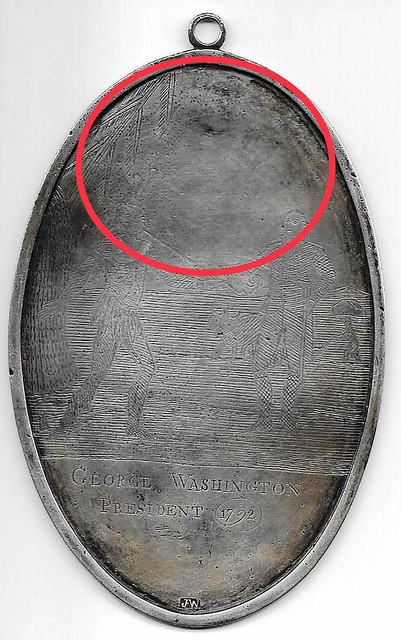 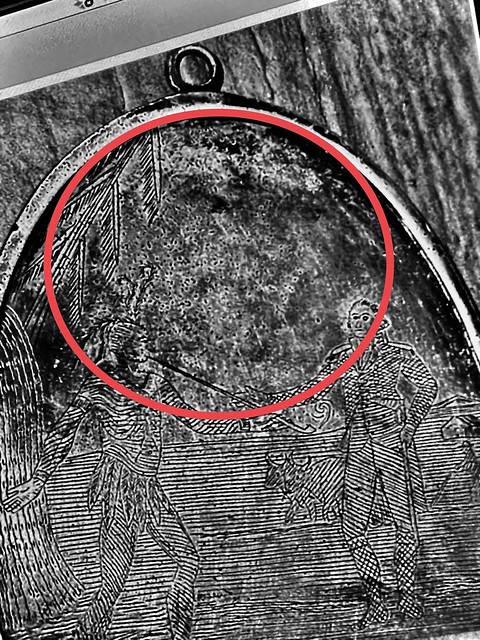 The images above show why Wright's engraving line work was not meant to be of quality like Richardson’s work. Wright focused his time on creating one of the most exquisite stipple piercing and shading portraits ever seen on a GW IPM. This is the first time the public gets to see what is believed to be the actual portrait of the recipient of the medal. The NY medal has been XRF tested with period results by Bruker Corporation’s personal representative, proving the medals are authentic with no traces of chemical manipulation of the patina to show fake aging. This February the NY, Wright medal was examined in hand by internationally renowned 9th generation silversmith Burt Boardman. Mr. Boardman’s forefathers were silversmiths before the 1750’s and established their family's company on the Connecticut river in 1789. The Boardman Silver manufacturing company is the oldest continuous operating silver company still in existence in United States history today. Mr. Boardman is one of the finest craftsman silversmiths living today, acknowledged by most all major auction houses as an authority on colonial silver identification, construction and silver manufacturing.
Boardman ran his thumb nail down the entire outside of the edge of the bezel and explained that the artist left an entire written cipher message on the edge of the bezel, all the way around the circumference of the medal. Boardman said, he could not translate the message, but is one of the few silversmiths today, who could authenticate that a written message is factually there. Messages of such on relics like this are an indication that the medal was very important. The message was either done by Wright or another silversmith. Boardman’s last words on the medal subject were “numismatist catalogers of stamped coins and stamped medals, have no business acting as authorities with auction houses on what's real and what's fake, unless they have decades working as silversmiths themselves." As always noted up front, The E-Sylm is a forum for numismatic discussion and not researched or independently fact-checked. Enlarged digital images present multiple problems, and controversy remains. As always, readers can click on images to see the full resolution original in our Flickr archive. As with the results of the 1792 Half Dime study above, we'll await the next published report and additional images and evidence. Gary has shared with me other images too numerous to publish here. There is also more information on Gary's blog, linked below. I highly recommend the video of his visit to Boardman Silversmiths - their collection of silver trophies and awards is mind-blowing. -Editor To read The Colonial Newsletter discussions, #159, see:
To watch the Boardman Silversmiths video, see:
To read Gary's blog, see:
 Wayne Homren, Editor The Numismatic Bibliomania Society is a non-profit organization promoting numismatic literature. See our web site at coinbooks.org. To submit items for publication in The E-Sylum, write to the Editor at this address: whomren@gmail.com To subscribe go to: https://my.binhost.com/lists/listinfo/esylum All Rights Reserved. NBS Home Page Contact the NBS webmaster 
|
